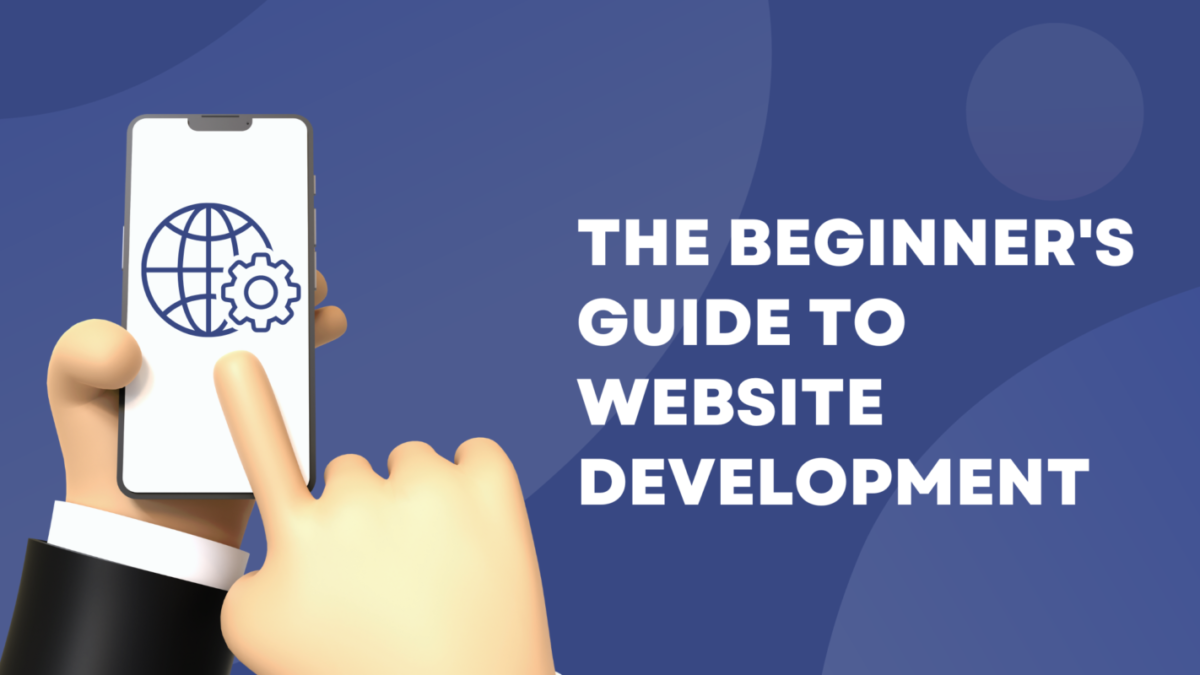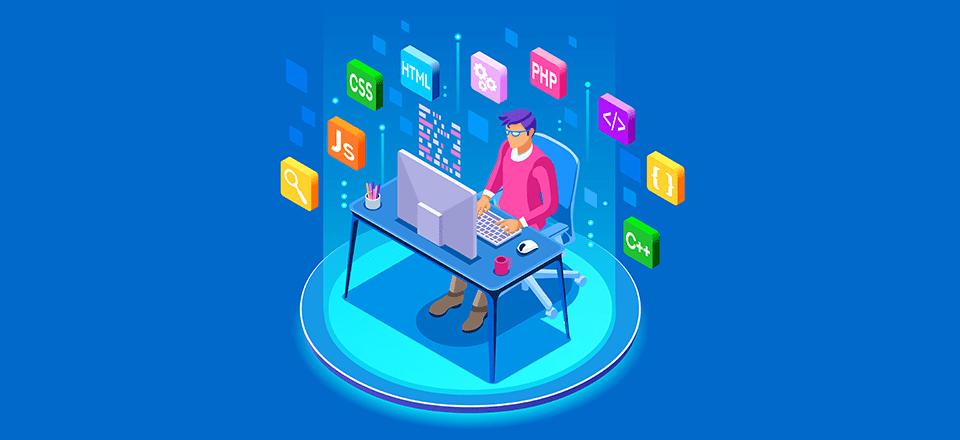
The Beginner’s Guide to Website Development
What is website development?
Website development is a catch-all term for the work that goes into building a website. This includes everything from markup and coding to scripting, network configuration, and CMS development.
While web development typically refers to web markup and coding, website development includes all related development tasks, such as client-side scripting, server-side scripting, server and network security configuration, eCommerce development, and content management system (CMS) development.
In this guide, we’ll cover the basics of web development, the process of creating a website, and additional resources for those who want to learn more about development — or become a developer themselves.

Why is web development important?
The Internet isn’t going anywhere. In fact, it’s become a portal and primary method of research, connection, education, and entertainment in the world. As of 2021, there were 4.66 billion global Internet users — more than half the world’s population.
Given the rapidly-increasing number of Internet users, it’s no surprise that web development is a rapidly expanding industry. Between now and 2030, the employment of web developers is expected to grow by 13%, much faster than most other technology careers..
Now, let’s dive into the web development process.

The Website Development Process
The process of creating a website isn’t as easy as 1-2-3. Each development path is different based on the type of website, programming languages, and resources.
The following section serves as a brief overview of the web development process and a short introduction to the most common languages and CMS options.
1. Form a plan.
Before laying pen to paper or hands to keyboard, it’s vital to first connect with teams and personnel across your organization to develop a plan for your website.
Here are some questions to consider before your first site draft:
- What is the goal of your website?
- Who is your audience, and what do you want them to do on your website?
- What type of website are you building? (e.g. basic informational, membership, online store)
- What content are you aiming to publish, and at what volume?
- What’s the purpose of this content?
- How will you structure your website for the best navigational experience?
- What’s your budget?
Answering the questions requires interfacing with your web development, marketing, and financial teams to determine your priorities and make informed decisions.
Put simply? It’s much easier to create a roadmap at the beginning of the process than reverting your progress at a roadblock.
2. Create a wireframe.
All good websites start with a blueprint. Developers call this a wireframe. It doesn’t have to be an official document; it’s simply a vision for your site that’ll give both you and your developer(s) direction and a place to start. You can draw it on a whiteboard or use a tool like Invision, Slickplan, or Mindnode.
Wireframes are strictly visual tools that will help you understand where text and images will go on individual webpages. You can use blank boxes and “dummy text” to get an idea of how your content will show up on the front-end. Work with your developer to create wireframes so that they have an idea of what you’re picturing.
3. Draft up a sitemap.
Next, it’s time to create a sitemap (not to be confused with sitemap.XML, which is an XML file that helps search engines crawl and find your site). Just like a business plan gives a potential investor insight into your goals and deliverables, a sitemap gives a developer the information needed to meet your vision. You can create your sitemap on your own or work with your developer(s).
Here are a few questions to ask yourself when planning your site:
- What individual pages do you want?
- What content will be on those pages?
- How can you organize those pages into categories?
- What is the hierarchy of pages on your site?
- How will the pages link together?
- What pages and categories are essential to your site and user experience?
- Which pages or categories could be removed or combined?
Again, it’s a good idea to consult with other teams within your organization. If you have an SEO and/or content strategy team, their input will be critical in the linking structure and categorizing of your pages.
4. Write your website code.
The next step in the web development process is writing the code.
Developers will use different coding languages for the front-end and back-end of websites, as well as for different functionalities of the site (such as design, interactivity, etc). These different languages work together to build and run your site.
Let’s start with the most commonly-used languages.
HTML
HyperText Markup Language (HTML) has been used since the 1990s. It’s the foundation of all websites and represents the bare minimum of what’s needed to create a website. While it’s possible to create a website with only HTML, it wouldn’t look particularly attractive.
Below is the HTML code for a basic Bootstrap button.
<button type=”button” class”btn”>Click Me</button>
Languages like CSS and JavaScript enhance and modify the basic site structure built by HTML codes. HTML5 is the most recent version and supports cross-platform browser functionality, making it popular in mobile application development.
CSS
Cascading Style Sheets (CSS) was developed in the late 1990s. It adds design elements like typography, colors, and layouts to websites to improve the overall “look” of websites.
CSS allows developers to transform your website to match the aesthetic you envisioned for your site, and like HTML5, CSS is compatible with all browsers.
JavaScript
JavaScript is the cherry-on-top of coding languages. Created in the mid-90s, JavaScript is used to add functionality to websites. Developers use it to add animations, automate tasks within certain pages, and add interactive features that enhance user experience.
JavaScript is rapidly evolving. Once considered a “toy” language, JavaScript is now the most widely used coding language in the world. With the help of Node.Js, it’s now a back-end coding language. It’s the first language to be understood by browsers, and some have even discussed applying machine learning to it, too.
Below is a JavaScript code snippet for automatically opening links in a new window in WordPress.
HTML, CSS, JavaScript are the “big three” of web development. Almost every website uses them in some capacity. There are plenty of others, such as server-side languages like Java, C++, Python, and SQL, but understanding these three is foundational to your website development knowledge.
5. Build the back-end of your website.
Writing code might be one of the more complicated parts of web development, but it’s hardly the only component. You also have to build your back-end and front-end site structures and design.
Let’s start with the back-end.
The back-end handles the data that enables the functionality on the front-end. For example, Facebook’s back-end stores my photos, so that the front-end can then allow others to look at them. It’s made up of two key components:
- Databases, which are responsible for storing, organizing, and processing data so that it’s retrievable by server requests.
- Servers, which are the hardware and software that make up your computer. Servers are responsible for sending, processing, and receiving data requests. They’re the intermediary between the database and the client/browser. The browser will, in effect, tell the server “I need this information”, and the server will know how to get that information from the database and send it to the client.
These components work together to build the foundation for each website.
As for building your website, backend developers will establish three things.
- Your logic code, which is a set of rules for how your website will respond to certain requests and how objects of your website will interact.
- Your database management, which is how your website will organize, manage, and retrieve its data.
- Your infrastructure, which is how your site will be hosted. Hosting your own site will give you greater control, but it’s much more expensive and requires you to maintain your own server health and security.
With these components and decisions in place, your website will be ready for front-end development.
Note: The back-end is slightly tangential to web development because you don’t always need a back-end if you’re not storing any data. “Data” in this context means any user-entered information that you need to save and persist. Think about logging in to a website. If they don’t have a back-end, how could they remember your login information? Or what your profile settings are? To get this information, you need a back-end.
Facebook, as an example, needs to know what people are in your Friends list, what events you have joined, what posts you have created, and more. This is all “data” that lives in a database. If they didn’t have a back-end with a database, none of that data would be accessible to them.
On the other hand, a website that’s purely informational and doesn’t require the users to enter any data wouldn’t need a back-end.
So, if you have no data, you don’t necessarily require back-end development. But that’s not saying you shouldn’t learn the basics. You never know when you might need it.
6. Build the front-end of your website.
If you’ve ever dabbled in web design or toyed with a website in WordPress, Squarespace, or Google Sites, you’ve touched front-end web development.
The front-end stuff is important — it’s what your visitors, customers, and users see and how they’ll use your website.
Front-end (or client-side) development includes a combination of JavaScript, HTML, and CSS. It also controls components such as typography and fonts, navigation, positioning, and browser compatibility and responsiveness. This part will reflect more of your initial site vision and what you included in your wireframe.
As technology and consumer preferences change, client-side coding tends to become outdated much faster than back-end development. This is where coding resources (like the ones we’ve included below) come in handy.
7. (Optional) Work with a CMS.
Why would someone choose a CMS over coding “by hand” or “from scratch?” It’s true that a CMS is less flexible and, therefore, gives you less control over your front-end. However, a CMS is easier to use (you have to write less code), and it often has tools for hosting the site, storing user information, creating a blog, publishing landing pages, capturing leads, and even building an email list. As a result, you’ll be able to make your website more profitable with less than half the work.
CMS options often include plugins that remove the need to write a back-end. For example, there are WordPress plugins for eCommerce so that, instead of building a complicated back-end to charge customers’ credit cards, you can just use an existing plugin and avoid the need to deal with databases and server-side code.
Popular content management systems include Joomla, Magento, and WordPress — which has over 65% market share. (In this case, we’re talking about open source WordPress software, not the WordPress site builder.)
8. Acquire a domain name.
At this point, your website will have an IP address. It also needs a domain name, a memorable website name that your visitors can use to find your site.
Perhaps you’ve heard of sites like GoDaddy and Hover. These services help you purchase a domain name and register with ICANN (Internet Corporation for Assigned Names and Numbers). Most domain registrations are good for a year before you’re required to renew.
Website builders and hosting services, like WordPress and Squarespace, also allow you to purchase a domain name.
9. Launch your site.
Once you’ve set up a domain name and linked it to your host, you’re almost ready to unveil your work to the web.
But not so fast — there are still a handful of things you’ll need to check before an official launch. These include planning out responsibilities on your team, testing your site thoroughly for any glitches, optimizing for SEO, and a final check before “flipping the switch” and making your site live.

Dive Into Web Development
The Internet is here to stay, and it’s constantly evolving to meet user needs. Web developers are on the front lines of these innovations and improvements — from this blog to your favorite social network to the apps you use on your phone, web development is everywhere.
As a result, it’s worth taking the time to understand coding and programming to help make your business website the best it can be — for you and your customers.


Leave a comment: